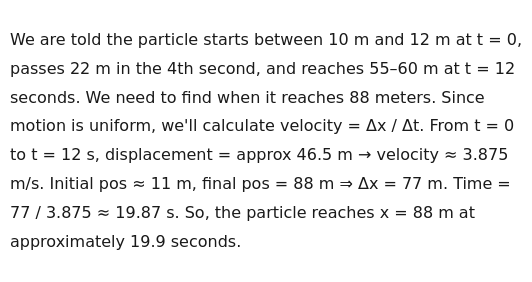Question
Question: We are told the particle starts between 10 m and 12 m at t = 0, passes 22 m in the 4th second, and r...
We are told the particle starts between 10 m and 12 m at t = 0, passes 22 m in the 4th second, and reaches 55–60 m at t = 12 seconds. We need to find when it reaches 88 meters. Since motion is uniform, we'll calculate velocity = Δx / Δt. From t = 0 to t = 12 s, displacement = approx 46.5 m → velocity ≈ 3.875 m/s. Initial pos ≈ 11 m, final pos = 88 m ⇒ Δx = 77 m. Time = 77 / 3.875 ≈ 19.87 s. So, the particle reaches x = 88 m at approximately 19.9 seconds.

19.9 seconds
Solution
The problem describes the motion of a particle with constant velocity (uniform motion). We are given ranges for the initial position, a position at an intermediate time, and a position at a later time. We need to find the time when the particle reaches a specific position.
Let the position of the particle be given by x(t)=x0+vt, where x0 is the initial position at t=0 and v is the constant velocity.
Given information:
- Initial position at t=0: x0∈[10,12] m.
- Passes 22 m in the 4th second: This means x(t1)=22 m for some t1∈(3,4] s.
- Reaches 55–60 m at t=12 seconds: x(12)∈[55,60] m.
- Find t when x(t)=88 m.
To find a single approximate answer, we can use the average values of the given ranges: Average initial position: x0=210+12=11 m. Average position at t=12 s: x(12)=255+60=57.5 m.
Now, we can calculate the average velocity using these average values: x(12)=x0+v×12 57.5=11+12v 12v=57.5−11 12v=46.5 v=1246.5=3.875 m/s.
Let's check if this average velocity is consistent with the "passes 22 m in the 4th second" condition. Using x0=11 m and v=3.875 m/s: x(t1)=11+3.875t1=22 3.875t1=11 t1=3.87511≈2.8387 s. This value of t1 is not in the 4th second (which is t∈(3,4] s). This indicates that the given conditions might not be perfectly consistent for a single exact uniform motion, or we need to consider the full ranges.
However, if the question expects a single numerical answer, the approach of using average values is common. Let's proceed with the calculated average velocity v=3.875 m/s and average initial position x0=11 m.
We need to find the time t when the particle reaches x(t)=88 m. x(t)=x0+vt 88=11+3.875t 3.875t=88−11 3.875t=77 t=3.87577 t≈19.87096 s
Rounding to one decimal place, t≈19.9 s.
Explanation of the solution:
- Assume uniform motion x(t)=x0+vt.
- Calculate average initial position x0=(10+12)/2=11 m.
- Calculate average position at t=12 s as x(12)=(55+60)/2=57.5 m.
- Determine average velocity v=(x(12)−x0)/12=(57.5−11)/12=46.5/12=3.875 m/s.
- Set up the equation for reaching 88 m: 88=x0+vt=11+3.875t.
- Solve for t: t=(88−11)/3.875=77/3.875≈19.9 s.
